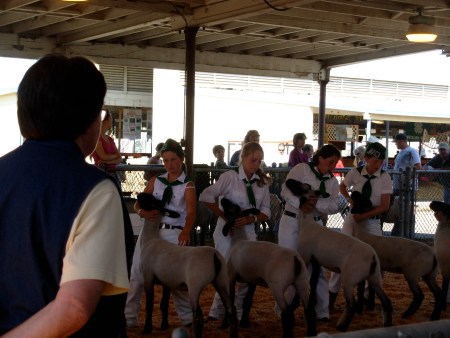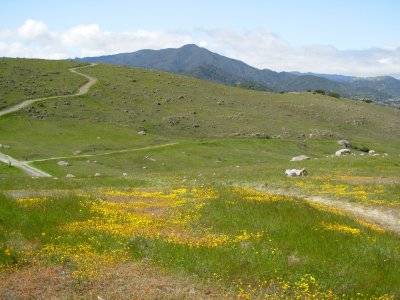
Few people can resist the delights offered by a pumpkin farm. They’re wonderful places for urban and suburban families to slow down just enough to feel the turning of the year and maybe try some harvest or other activities from times past. And, of course, there are the pumpkins themselves — jolly orbs that lay in profusion among pastures until you, the visitor, pick the most perfect among them to take home.
With Halloween almost upon us, most pumpkin farms have gone into high gear, with lots of activities over longer hours, and a host of pumpkins still available for the picking. Included in this listing are working farms and special pumpkin patches in the North, East and South Bays.

North Bay
Peterson’s Pumpkins and Dried Flowers, Petaluma
This working farm opens to the public for Halloween. Families may visit on weekends or after 2 on weekdays. In addition to two large, natural pumpkin fields, Peterson’s has lots of animals to feed and pet, including chickens, ducks, geese, turkeys, cows, ponies, rabbits, pigs, calves, and a very big but gentle bull known as Wooly Monster. There are also fresh vegetables, flowers, free-range eggs, and an observational bee hive, all in a very intimate farm setting.
See the Peterson’s web site for directions and more information.
Peter Pumpkin Patch, Petaluma
This large, beautifully situated pumpkin farm in the Chileno Valley is also the home of Spring Hill Jersey Cheese. Visitors can milk a cow or dig for potatoes in a potato field, in addition to buying some of the best homemade ice cream around (pumpkin and vanilla) and specialty farmstead cheeses.
See the Peter Pumpkin Patch web site for directions and more information.
Adobe Pumpkin and Flower Farm
This 30-acre farm has thousands of pumpkins and gourds for the picking, along with U-cut zinnias and sunflowers, and vegetables. Adobe also has a great corn maze, a hay ride, a haunted barn, a jump house, animals, crafts, and food and live entertainment on weekends.
See the Adobe Farms web site for directions and more information.
Nicasio Valley Farms, Nicasio
Along with a large, picturesque pumpkin field, Nicasio Valley Farms offers U-pick strawberries, lots of gourds, and a farmstand featuring a complete array of fresh organic vegetables, as well as eggs, breads and cheeses. There is a hay ride, a hay maze and a jump house.
Call Nicasio Valley Farms at (415) 662-9100 for directions and more information.

East Bay
Smith Family Farm, Brentwood
Smith Family Farm has been in the same family for three generations and offers lots of great old-time activities on its large farm. There’s a leisurely tractor-pulled hay ride out to the pumpkin field, a corn maze, a hay maze, displays of antique farm equipment, live entertainment in a barn, a host of animals, and lots of fresh U-pick produce. The farm offers lots of places to picnic and play in a large, varied ranch setting.
See the Smith Valley Farm web site for directions and more information.
Clayton Valley Pumpkin Farm, Clayton
Clayton Valley Pumpkin Farm, at the base of Mount Diablo, features a large variety of pumpkins and squash in all shapes and even colors. This working farm offers lots of fun activities for all ages, including a trackless train, a playland featuring old-fashioned games, and plenty of farm animals. The farm represents a part of the area’s rural past that is largely disappearing.
See the Clayton Valley Farm web site for directions and more information.
Joan’s Farm and Pumpkin Patch, Livermore
This large, pretty working farm offers a taste of the Old West: There’s an Old West town, gold panning, antique farm equipment, a museum, and more. There’s also a large corn maze, hay rides, farm animals, and a farmstand with fresh produce for sale.
See the Joan’s Farm web site for directions and more information.

South Bay
Half Moon Bay bills itself as the “Pumpkin Capitol of the World” for good reason. Many people know about its yearly Art and Pumpkin Festival, which occurs each year in mid-October. Less well-known is the bounty of area farms, many of which have been in families for generations, along Highways 1 and 92.
Farmer John’s Pumpkin Farm, Half Moon Bay
This delightful pumpkin patch offers an extremely large variety of pumpkins, all grown on-site. This working farm also features a hay pyramid, scarecrows, play areas, a Native American tipi, cornrows, U-pick sunflowers, and an antique John Deere tractor. The farm is wheelchair-accessible.
See the Farmer John’s Pumpkin Farm web site for directions and more information.
Arata’s Pumpkin Farm, Half Moon Bay
Open since 1932, Arata’s is one of the oldest working pumpkin farms in the Bay Area. In addition to pumpkins, enjoy pony rides, animals, a hay ride, and a huge hay maze — clearly a labor of love — constructed out of 10,000 bales of hay.
See the Arata’s Pumpkin Farm web site for directions and more information.
Little Creek Ranch Pumpkin Farm, Half Moon Bay
Just up the road from Arata’s, Little Creek is a delightful family farm and pumpkin patch suitable for very young children. Pumpkins lay far apart on flat ground, so there are no vines to trip over. The entire pumpkin area is surrounded by low hay bales. There is a play structure and pony rides, along with other animals.
Call Little Creek Ranch at (650) 726-2765 for directions and more information.
Pastorino Farms, Half Moon Bay
Pastorino Farms dates from the 30s and is known today for its huge assortment of pumpkins, along with its big orange-and-black decorated barn. Pastorino offers train rides around a small track, a jump house, pony rides, and a petting zoo. Hand-made signs that identify the many different types of pumpkins, some of them quite unusual. Also nice is the farm’s large selection of Halloween decorations and kitchen wares.
See the Pastorino Farms web site for directions and more information.
Lemos Farm, Half Moon Bay
A working farm since 1942, this popular, charming spot offers lots of activities for all ages, especially young children. In addition to a good selection of pumpkins, Lemos Farm features pony rides, hay rides, a hay maze, a train for small children, a toddler-oriented play zone, haunted houses for older and younger children, and animals you can feed and pet. Lemos Farm retains a great deal of charm from the South Bay’s rural past.
See the Lemos Farm web site for directions and more information.
Have fun!




Photos by Susan Sachs Lipman




















































































































